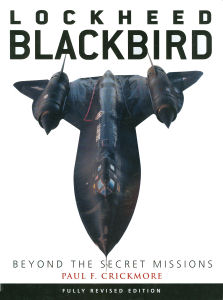
Lockheed Blackbird Book Review
By Michael Benolkin
| Date of Review | April 2010 | Title | Lockheed Blackbird |
|---|---|---|---|
| Author | Paul F. Crickmore | Publisher | Osprey Publishing |
| Published | 2010 | ISBN | 978-1-84603-846-4 |
| Format | 400 pages, softbound | MSRP (USD) | $24.95 |
Review
Before the days of satellite reconnaissance, the only way to gather intelligence behind an adversary's lines was to either sneak in on the ground or overfly the areas of interest. During the Cold War, Lockheed's first purpose built spyplane, the famous U-2, roamed the skies with near impunity until the deployment of Soviet surface-to-air missile (SAM) technology. Gary Francis Powers was the first casualty of the U-2 versus SAM duel and wouldn't be the last.
Lockheed's visionary designer, Kelly Johnson, set his famous Skunkworks to the problem of getting a manned reconnaissance aircraft to operate at much higher speeds and greater altitudes than the U-2. First built for the CIA, the resulting single-seat A-12 was able to cruise above Mach 3 and easily exit a SAM's lethal envelope before the missile could reach the aircraft. A derivative aircraft used to hide the A-12 in plain sight was the YF-12 interceptor which provided a significant intercept capability for the USAF as well as provided plausible deniability for the A-12 should it be spotted. Lockheed continued development of the type with reconnaissance operations shifting over to USAF, and the new two-seat reconnaissance aircraft became the SR-71.
The SR-71 would provide essential reconnaissance services to the US intelligence community to ensure that perceived threats could be diplomatically dealt with before the Cold War could erupt into World War III. First entering service in 1966, the SR-71 could operate above Mach 3.2 and at altitudes that earned its crew the right to wear astronaut wings. The aircraft helped to preserve the peace of the world for over 30 years before being retired. Even today, over 10 years after its retirement, the SR-71 is still aerodynamically the most advanced design to enter service.
You might recall seeing this title previously, it was initially published in 1993. At that time, the author had collected a significant amount of information about the Blackbird, but there was far more information that would have to go untold given that the aircraft was still operational at that time. With the declassification of far more information as well as the fall of the Iron Curtain, the author has provided a significant update to his original edition to help tell "the rest of the story" (as Paul Harvey used to say).
With the addition of this new data, the author has filled in some blanks from the first edition, added previously unpublished new history, and added the most complete reference of the aircraft ever to be published. In the appendices alone are the mission logs for SR-71 operations, disposition of all airframes, and even the pilot's logbook excerpt from a MiG-31 pilot that used to escort the Blackbird away from his assigned area.
This is a must-have for the aviation historian and the modeler alike. This title is the ultimate Blackbird lover's reference. In this day and age, when was the last time you saw a quality 400 page reference for under $25 USD? Kudos to Osprey Publishing for this feat!
My sincere thanks to Osprey Publishing for this review sample!







